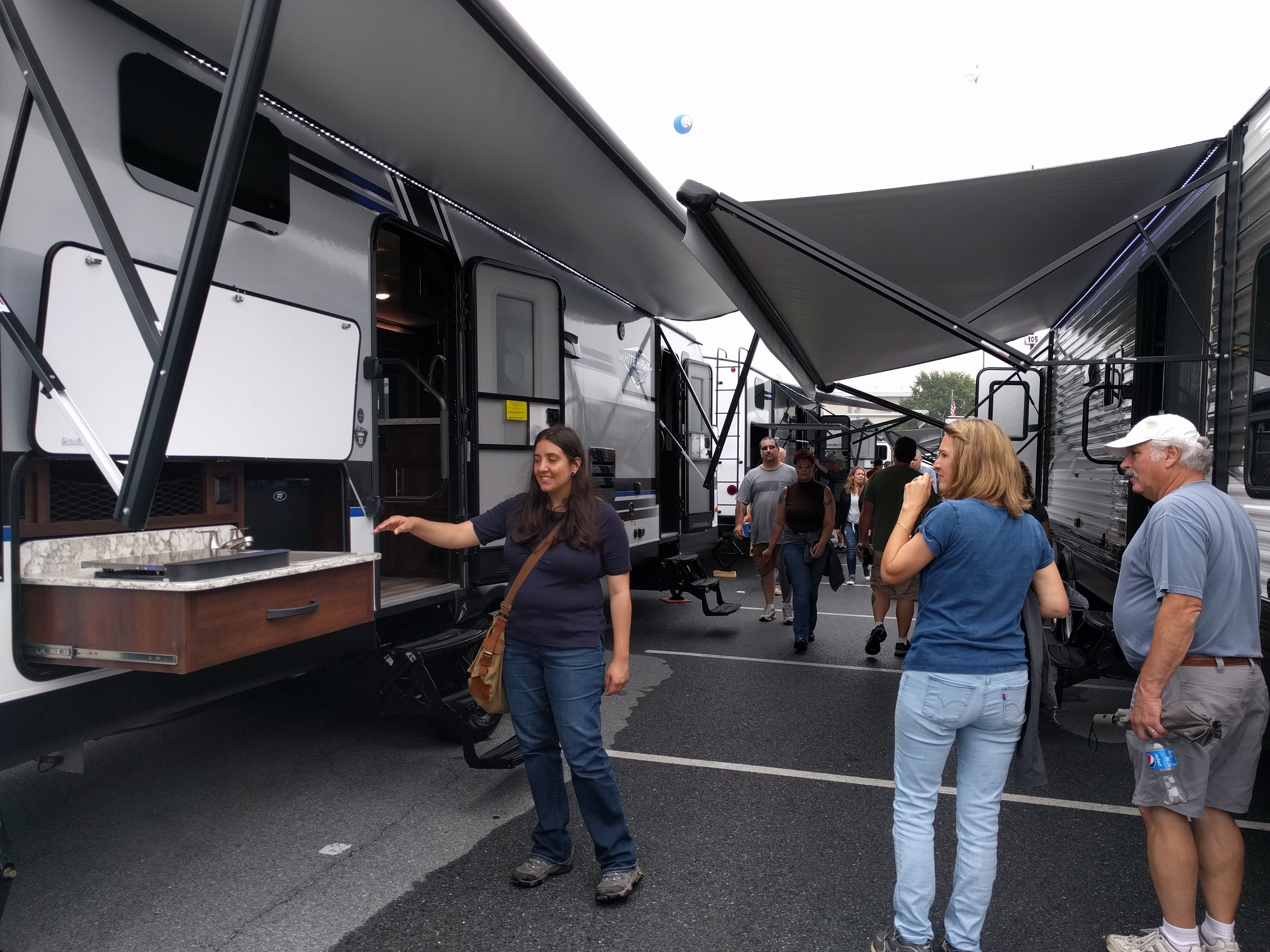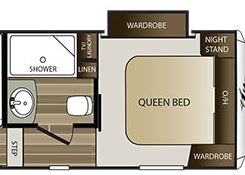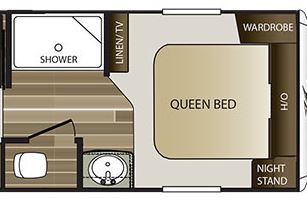Finding the right RV
Now that we have a truck, next up is purchasing an RV. We’ve done quite a bit of research, narrowed down our list of desired features, and selected a few favorite models to search for. The advice I’ve read says that you won’t really know what you need in an RV until you’ve spent some time living in one, so it’s not worth stressing out looking for the perfect RV the first time around. We’re trying to keep that in mind here.
We want to have our RV by the beginning of May, so the plan is to start by looking for our favorites but relax our requirements as that deadline approaches.
It will be interesting to look back on this list after a year of travel to see what we had right and what we had completely wrong.
RV Types
If you aren’t familiar with the various types of RV, here is a quick rundown of the most common ones.

Class A

Class B

Class C

Travel Trailer

5th Wheel
Class A, B, and C are all styles where you drive the RV. These have the benefit that you can access the interior of the RV while driving, and they’re a bit faster to set up when you arrive at a new campsite, so they’re a good choice if you’re going to be traveling a lot like we are. Class B and C RVs are a bit too small for what we need, though. We did seriously consider class As, but we were not thrilled about the idea of towing a small vehicle behind it.
Ultimately, we decided to focus on towable RVs. With that style, the cost is more evenly split between the truck and RV, and that should be a bit safer when it comes time to sell. Maintenance should also be easier since any shop can work on a truck versus RVs which require specialized shops. I think a truck will also be less intimidating to drive, and that is important since neither Sushila nor I have any experience driving or towing large vehicles.
In the towable class, there are two main options: Travel Trailers and 5th wheels. Generally speaking, travel trailers are a bit smaller and have less storage than an equally sized 5th wheel. For weekend trips, a travel trailer would probably be great, but for living in it full time, I think we’ll need the additional storage space. Travel trailers are also supposed to be a bit harder to tow. We did consider an Airstream travel trailer since I like the look, and they are supposed to be really well made. We toured a few at the RV show, though, and they just didn’t feel like a good fit. Given those considerations, we settled on narrowing our search to 5th wheel RVs.
Finding the right RV
Within the 5th wheel class, there is still a lot of variation in terms of size, design, and functionality. While we were pretty confident that a 5th wheel would be best for us based on internet research, it’s really hard to know what size and layout is going to feel comfortable without seeing some in person. For that, we went to the RV show in Hershey, PA, last fall.

Length
Our goal is to find the smallest RV size that still feels comfortable. Many campgrounds, especially in state parks, allow a maximum length of 30-35’, and we want to keep as many options open as possible. Additionally, a larger RV will be more expensive to buy, more expensive to maintain, and more difficult to tow. On the other hand, we don’t want to feel cramped. Based on my internet searches, I was pretty sure we’d want at least a 35’ RV, but after seeing them in person, even RVs under 25’ felt comfortable, so we’re pretty confident that an RV in the 25-30’ range will be perfect.
Floor Plan
There are a lot of subtle variations in RV floor plans, but generally speaking, within our size range, they all have a living room/kitchen in the back and a bedroom/bathroom in the front.
Bedroom
Our only real requirement for the bedroom is that we can fit a queen size bed. That’s what we currently have, and it is borderline too small, so we definitely can’t downsize. Luckily, it seems like all RVs in our size range have at least a queen size bed, and some even have a king. If we could find an RV with a king size bed, that would be awesome, but we aren’t going to limit ourselves to it since it seems pretty rare.
We like models that include one slide 1 in the bedroom. We really prefer layouts where the bed is within the slide because the very front of the RV can then be used as a large, walk-in closet. These seem pretty rare, unfortunately. In most cases, the slide ends up being a wardrobe, and there is significantly less storage space.
For the bathroom, there are two options. The most common is a traditional bathroom that includes the shower, sink, and toilet in the same room 2. We really prefer the layouts that split the bathroom 3, though. The shower and sink end up being part of the bedroom, and the toilet has its own, much smaller room. Since it’s just the two of us, we don’t really need the extra privacy, and that layout ends up leaving the bedroom feeling much more open. This isn’t a hard requirement, but it’s high on the list
Living Room
The biggest decision for living room layouts is whether you have one or two slides. Having two slides gives you more space, but the extra space doesn’t seem like it will be very useful since it’s just an open area in the middle of the RV. In addition, with two slides you can barely move through the RV without the slides extended (and in some cases, you can’t at all). Since we’ll be on the move a lot, we would like to be able to use the RV without extending the slides. This makes the one-slide layout a high priority for us.
Within the one-slide models, there are still some where access to the fridge or bedroom is blocked when the slide is pulled in. This is a deal breaker, and we’ll avoid any models with that limitation. Luckily, most one-slide models only end up blocking the TV when the slide is in, and that is an acceptable trade-off for the extra space we’ll get.
The only other major consideration is whether the entrance is in the middle or back of the RV. When the entrance is in the middle, the rear of the RV often ends up being wasted space. In this layout, the kitchen will run from the door to the rear of the RV, so there isn’t enough space to fit a couch, but if the kitchen wraps around the rear of the RV, the slide will end up blocking the fridge or something else important. The wrap-around kitchens also lose the huge window at the back, and I really want to have that big window 4. When the door is at the back of the RV, there is usually a nice space for a couch (which we’ll probably remove and replace with a desk).
Within the slide itself, there is almost always a couch and a table, so there isn’t much decision to be made there. You do have the option of a booth-style table vs. regular table, but we don’t have a strong feeling one way or the other on that.
Other Considerations
Aside from length and layout, the only other major consideration we have is holding tank size. All RVs in our size-range will have a tank for drinking water, grey water, and black water, but the sizes of those tanks vary. I really want to be able to spend time boondocking 5 while we travel, and having larger tanks will mean we can stay in locations without water/sewer for longer periods of time. This one isn’t a deal breaker since I’m sure we can be more conservative with water if required, but we’ll be more comfortable if we can find an RV with larger tanks.
Modifications
Regardless of which RV we get, there are a few modifications that we’re planning to make to fit our needs.
Kitties
We’re going to need a good place to keep the litter box for the kitties. Some people will store it in the shower or under the table, but we really don’t like either option. We found a great idea on Youtube, though. Assuming we have some empty space behind the steps in the RV, we’d like to put a cat door in and build a compartment for the litter box that is hidden away and accessible from outside.
Ollie is a climber, so we’d like to give him a perch he can use to survey his domain and seek refuge from Mango. This one will depend a lot on the specific layout we end up with, but hopefully we can work something out for him.
Work
Sushila already tends to work from the couch or bed, so we won’t need to do much to set up for her. I would like to bring my desktop computer for photo/video editing, though, and that will require some space. We’d like to replace some extra seating with a desk that I can use.
Solar
Since everything we do for work and play revolves around electronic devices, we’re going to need consistent access to electricity. We do not want to be limited to campgrounds with electric hookups, so we’ll need to be self-sufficient. We’ll have a generator we can use when necessary, but we’re hoping that it serves as a supplement, and our main source of off-grid power will be solar. If we can find a used RV that already has solar installed, that would be great, but if not, we’ll have to do it ourselves.
Ideal RV
Right now, our top choices for RV models are:
- Forest River Wildcat Maxx 272RLX
- Keystone Montana 2955RL
- Keystone Cougar High Country 291RLS
- Coachmen Chaparral 276RLS
If we can’t find one of these available within a reasonable driving distance, though, then we’ll expand the search to other similar models.
Hopefully we’ll find the perfect RV.
An RV slide is the part that expands to give more interior space when the RV is parked. There are pros and cons to having them, but I don't think any recently-build RVs come without any. We want to limit ourselves to 1 or 2, though.


Boondocking, dry camping, and wild camping are all terms for camping without connections for power, water, or sewer (aka hookups). This can apply to traditional campgrounds without hookups, but it's most commonly used to refer to camping on free public lands such as BLM or National Forest areas.

